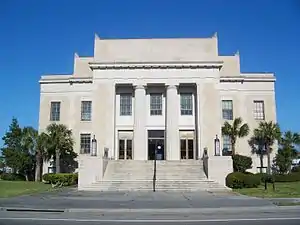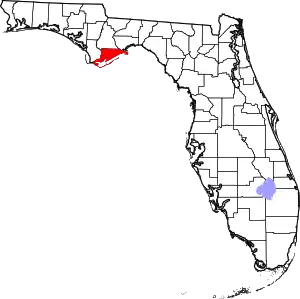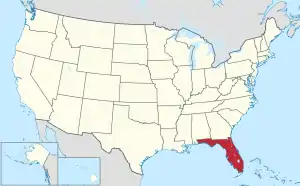Franklin County, Florida
Franklin County is a county along the Gulf of Mexico in the panhandle of the U.S. state of Florida. As of the 2020 census, the population was 12,451,[1] making it the third-least populous county in Florida. The county seat is Apalachicola.[2]
Franklin County | |
|---|---|
 Franklin County Courthouse | |
 Location within the U.S. state of Florida | |
 Florida's location within the U.S. | |
| Coordinates: 29°48′N 84°49′W | |
| Country | |
| State | |
| Founded | February 8, 1832 |
| Named for | Benjamin Franklin |
| Seat | Apalachicola |
| Largest community | Eastpoint |
| Area | |
| • Total | 1,026 sq mi (2,660 km2) |
| • Land | 535 sq mi (1,390 km2) |
| • Water | 492 sq mi (1,270 km2) 47.9% |
| Population (2020) | |
| • Total | 12,451 |
| • Density | 23/sq mi (9/km2) |
| Time zone | UTC−5 (Eastern) |
| • Summer (DST) | UTC−4 (EDT) |
| Congressional district | 2nd |
| Website | www |
The county includes several large preserved areas and rivers and has been home to commercial timber and fishing industry. More recently it has become popular for tourism and retirement. It includes several rivers, state parks, and islands.
History
Franklin County was founded in 1832.[3] It was named for Benjamin Franklin.[4]
The second largest town in Franklin County is Carrabelle, 25 miles east of Apalachicola on the Carrabelle River.
Camp Gordon Johnston
During World War II most of Franklin County was used by the U.S. Army for amphibious and jungle training, for which the beaches and islands were ideal. When the war ended and the military left, Lanark Village was established from the remaining officer's quarters.
Geography
According to the U.S. Census Bureau, the county has a total area of 1,026 square miles (2,660 km2), of which 535 square miles (1,390 km2) is land and 492 square miles (1,270 km2) (47.9%) is water.[5]
Franklin County includes part of Tate's Hell State Forest. Bald Point State Park is nearby. The county's river's include the Carrabelle River and its tributaries the New River (Florida Panhandle) and Crooked River (Florida), visited by paddlers. The extreme eastern tip of the county is bordered by the Ochlockonee River.
Adjacent counties
- Liberty County, Florida – north
- Wakulla County, Florida – northeast
- Gulf County, Florida – west (northern part of the county observes CDT/CST time)
National protected areas
Barrier Islands
Also, St. James Island, while part of the mainland, is technically an island, being separated from the rest of Franklin County by rivers and an estuary.
Historic sites
Demographics
| Census | Pop. | Note | %± |
|---|---|---|---|
| 1840 | 1,030 | — | |
| 1850 | 1,561 | 51.6% | |
| 1860 | 1,904 | 22.0% | |
| 1870 | 1,256 | −34.0% | |
| 1880 | 1,791 | 42.6% | |
| 1890 | 3,308 | 84.7% | |
| 1900 | 4,890 | 47.8% | |
| 1910 | 5,201 | 6.4% | |
| 1920 | 5,318 | 2.2% | |
| 1930 | 6,283 | 18.1% | |
| 1940 | 5,991 | −4.6% | |
| 1950 | 5,814 | −3.0% | |
| 1960 | 6,576 | 13.1% | |
| 1970 | 7,065 | 7.4% | |
| 1980 | 7,661 | 8.4% | |
| 1990 | 8,967 | 17.0% | |
| 2000 | 11,057 | 23.3% | |
| 2010 | 11,549 | 4.4% | |
| 2020 | 12,451 | 7.8% | |
| U.S. Decennial Census[6] 1790-1960[7] 1900-1990[8] 1990-2000[9] 2010-2015[1] 2019[10] | |||
| Race | Pop 2010[13] | Pop 2020[14] | % 2010 | % 2020 |
|---|---|---|---|---|
| White (NH) | 9,188 | 9,798 | 79.56% | 78.69% |
| Black or African American (NH) | 1,574 | 1,403 | 13.63% | 11.27% |
| Native American or Alaska Native (NH) | 52 | 41 | 0.45% | 0.33% |
| Asian (NH) | 26 | 30 | 0.23% | 0.24% |
| Pacific Islander (NH) | 2 | 2 | 0.02% | 0.02% |
| Some Other Race (NH) | 3 | 41 | 0.03% | 0.33% |
| Mixed/Multi-Racial (NH) | 175 | 461 | 1.52% | 3.7% |
| Hispanic or Latino | 529 | 675 | 4.58% | 5.42% |
| Total | 11,549 | 12,451 | 100.00% | 100.00% |
As of the 2020 United States census, there were 12,451 people, 4,691 households, and 2,926 families residing in the county.
As of the census[15] of 2000, there were 11,057 people, 4,096 households, and 2,727 families residing in the county. The population density was 20 people per square mile (7.7 people/km2). There were 7,180 housing units at an average density of 13 per square mile (5.0/km2). The racial makeup of the county was 81.24% White, 16.32% Black or African American, 0.45% Native American, 0.20% Asian, 0.02% Pacific Islander, 0.43% from other races, and 1.34% from two or more races. 2.42% of the population were Hispanic or Latino of any race.
There were 4,096 households, out of which 24.80% had children under the age of 18 living with them, 52.50% were married couples living together, 9.80% had a female householder with no husband present, and 33.40% were non-families. 28.70% of all households were made up of individuals, and 11.80% had someone living alone who was 65 years of age or older. The average household size was 2.28 and the average family size was 2.77.
In the county, the population was spread out, with 18.00% under the age of 18, 7.60% from 18 to 24, 30.80% from 25 to 44, 27.80% from 45 to 64, and 15.70% who were 65 years of age or older. The median age was 41 years. For every 100 females there were 129.60 males. For every 100 females age 18 and over, there were 135.70 males.
The median income for a household in the county was $26,756, and the median income for a family was $31,157. Males had a median income of $25,101 versus $20,494 for females. The per capita income for the county was $16,140. About 11.80% of families and 17.70% of the population were below the poverty line, including 23.20% of those under age 18 and 13.90% of those age 65 or over.
Education
Franklin County residents are within the Franklin County School District.[16] All Students K-12 attend the Franklin County School at Eastpoint, FL, except those attending the Apalachicola Bay Charter School or other private schools.
Libraries
The Franklin County Public Library works with the Wilderness Coast Public Libraries. The FCPL has two library branches.
- Carrabelle
- Eastpoint
In addition, Franklin County has the Apalachicola Margaret Key Library, an independent library with a history of providing services for over 100 years. It is not a member of Wilderness Coast, but is recognized the state.
Politics
Voter Registration
| Franklin County Voter Registration & Party Enrollment as of April 30, 2022 | |||||
|---|---|---|---|---|---|
| Political Party | Total Voters | Percentage | |||
| Democratic | 3,115 | 42.00% | |||
| Republican | 3,408 | 45.95% | |||
| Independent | 755 | 10.47% | |||
| Third Parties | 138 | 1.91% | |||
| Total | 7,416 | 100.00% | |||
Statewide Elections
| Year | Republican | Democratic | Third party | |||
|---|---|---|---|---|---|---|
| No. | % | No. | % | No. | % | |
| 2020 | 4,675 | 68.16% | 2,120 | 30.91% | 64 | 0.93% |
| 2016 | 4,125 | 68.08% | 1,744 | 28.78% | 190 | 3.14% |
| 2012 | 3,570 | 64.98% | 1,845 | 33.58% | 79 | 1.44% |
| 2008 | 3,818 | 63.12% | 2,134 | 35.28% | 97 | 1.60% |
| 2004 | 3,472 | 58.54% | 2,401 | 40.48% | 58 | 0.98% |
| 2000 | 2,454 | 52.83% | 2,047 | 44.07% | 144 | 3.10% |
| 1996 | 1,563 | 34.20% | 2,096 | 45.86% | 911 | 19.93% |
| 1992 | 1,664 | 37.99% | 1,535 | 35.05% | 1,181 | 26.96% |
| 1988 | 1,913 | 58.52% | 1,283 | 39.25% | 73 | 2.23% |
| 1984 | 2,218 | 67.05% | 1,090 | 32.95% | 0 | 0.00% |
| 1980 | 1,508 | 44.59% | 1,775 | 52.48% | 99 | 2.93% |
| 1976 | 1,054 | 35.45% | 1,859 | 62.53% | 60 | 2.02% |
| 1972 | 2,277 | 82.14% | 490 | 17.68% | 5 | 0.18% |
| 1968 | 529 | 16.86% | 699 | 22.28% | 1,909 | 60.85% |
| 1964 | 1,419 | 50.95% | 1,366 | 49.05% | 0 | 0.00% |
| 1960 | 764 | 33.84% | 1,494 | 66.16% | 0 | 0.00% |
| 1956 | 571 | 37.34% | 958 | 62.66% | 0 | 0.00% |
| 1952 | 611 | 33.04% | 1,238 | 66.96% | 0 | 0.00% |
| 1948 | 130 | 12.24% | 635 | 59.79% | 297 | 27.97% |
| 1944 | 102 | 7.98% | 1,176 | 92.02% | 0 | 0.00% |
| 1940 | 102 | 6.79% | 1,400 | 93.21% | 0 | 0.00% |
| 1936 | 125 | 8.13% | 1,413 | 91.87% | 0 | 0.00% |
| 1932 | 99 | 9.37% | 958 | 90.63% | 0 | 0.00% |
| 1928 | 334 | 44.30% | 417 | 55.31% | 3 | 0.40% |
| 1924 | 109 | 20.00% | 417 | 76.51% | 19 | 3.49% |
| 1920 | 276 | 29.18% | 587 | 62.05% | 83 | 8.77% |
| 1916 | 81 | 16.80% | 312 | 64.73% | 89 | 18.46% |
| 1912 | 58 | 14.87% | 266 | 68.21% | 66 | 16.92% |
| 1908 | 112 | 22.54% | 283 | 56.94% | 102 | 20.52% |
| 1904 | 144 | 29.69% | 336 | 69.28% | 5 | 1.03% |
| Year | Republican | Democratic | Third parties |
|---|---|---|---|
| 2022 | 73.56% 4,003 | 25.84% 1,406 | 0.61% 33 |
| 2018 | 64.72% 3,508 | 33.03% 1,790 | 2.25% 122 |
| 2014 | 58.17% 2,505 | 37.92% 1,633 | 3.91% 168 |
| 2010 | 47.72% 1,938 | 47.89% 1,945 | 4.39% 178 |
| 2006 | 49.89% 1,981 | 46.69% 1,854 | 3.42% 136 |
| 2002 | 47.81% 1,819 | 50.75% 1,931 | 1.45% 55 |
| 1998 | 56.08% 1,536 | 43.92% 1,203 | |
| 1994 | 33.43% 1,324 | 66.57% 2,636 |
Communities
Towns
Census-designated places
Unincorporated communities
Transportation
Airports
- Apalachicola Regional Airport
- Carrabelle-Thompson Airport
- St. George Island Airport
Notes
References
- "State & County QuickFacts". United States Census Bureau. Archived from the original on June 7, 2011. Retrieved February 12, 2014.
- "Find a County". National Association of Counties. Archived from the original on May 31, 2011. Retrieved June 7, 2011.
- Publications of the Florida Historical Society. Florida Historical Society. 1908. p. 31.
- Gannett, Henry (1905). The Origin of Certain Place Names in the United States. Govt. Print. Off. pp. 131.
- "US Gazetteer files: 2010, 2000, and 1990". United States Census Bureau. February 12, 2011. Retrieved April 23, 2011.
- "U.S. Decennial Census". United States Census Bureau. Retrieved June 13, 2014.
- "Historical Census Browser". University of Virginia Library. Retrieved June 13, 2014.
- "Population of Counties by Decennial Census: 1900 to 1990". United States Census Bureau. Retrieved June 13, 2014.
- "Census 2000 PHC-T-4. Ranking Tables for Counties: 1990 and 2000" (PDF). United States Census Bureau. Retrieved June 13, 2014.
- "QuickFacts. Florida counties". Retrieved May 20, 2020.
- https://www.census.gov/
- "About the Hispanic Population and its Origin". www.census.gov. Retrieved May 18, 2022.
- "Explore Census Data". data.census.gov. Retrieved May 27, 2022.
- "Explore Census Data". data.census.gov. Retrieved May 27, 2022.
- "U.S. Census website". United States Census Bureau. Retrieved May 14, 2011.
- "2020 CENSUS - SCHOOL DISTRICT REFERENCE MAP: Franklin County, FL" (PDF). U.S. Census Bureau. Retrieved July 31, 2022. - Text list
- Leip, David. "Dave Leip's Atlas of U.S. Presidential Elections". uselectionatlas.org. Retrieved June 14, 2018.
